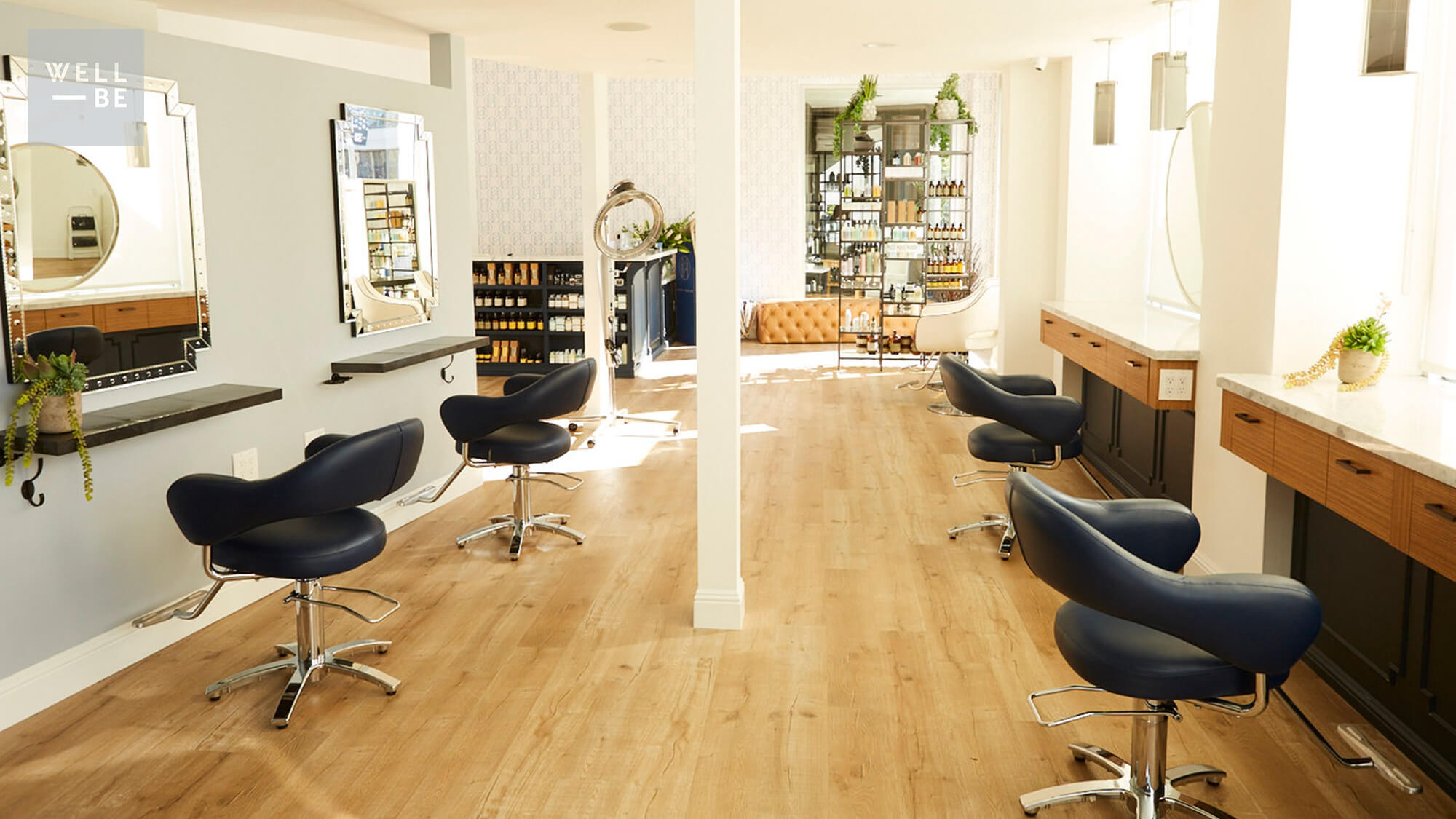When it comes to transforming your look with a new hair color or highlights, the initial thought might be about choosing the perfect shade. However, a more critical question should be: “Where can I find the best organic salon near me?” The truth is, conventional hair salons often utilize products brimming with harmful chemicals, making the quest for a truly non-toxic hair dye paramount for your well-being. But fear not, embracing a healthier approach to hair coloring doesn’t mean sacrificing your desired look—you might even discover that you can maintain your current stylist while sill making safer choices. This comprehensive guide delves into the potential health risks associated with traditional salon practices, highlights exceptional organic hair salon options in major cities, and provides actionable steps to safeguard your health, regardless of your chosen salon.
To get our vetted recommendations for organic hair salons near you, you can download our free guide. It includes WellBe-approved salons in Atlanta, Boston, Chicago, Dallas, Houston, London, Los Angeles, New York, Philadelphia, Seattle, San Francisco, and Washington D.C., as well as our advice for those who don’t live in any of those cities.
DOWNLOAD MY FREE ORGANIC HAIR SALON CITY GUIDE!
Why Prioritizing Non-Toxic Hair Dye is Crucial for Your Health
Have you ever tried to recall your best friend’s natural hair color? This seemingly simple question can be surprisingly challenging, as a significant majority of American women color or highlight their hair. Current statistics reveal that approximately 75% of American women color their hair—a figure that has steadily climbed over the past decades. While the freedom to experiment with hair color is certainly appealing, the chemical cocktail found in many conventional hair dyes and other salon products can pose serious health concerns. This makes the conscious decision to seek out non-toxic hair dye a vital step for everyone.
Consider the extensive chemical processes required to drastically alter hair color, for instance, transforming dark brown to blonde. For years, salons and major cosmetic companies have relied on potent chemicals to achieve these dramatic results. While formulations vary, several particularly hazardous chemicals commonly found in hair dyes warrant your attention:
- p-Phenylenediamine (PPD): This widely used chemical is present in roughly two-thirds of conventional hair dyes in the U.S. Despite its prevalence, PPD is so dangerous that it is banned in Germany, France, and Sweden. The Environmental Working Group (EWG) rates PPD a 7 out of 10 for toxicity, linking it to serious health risks, including cancer. A 2001 study from the University of Southern California indicated that women who colored their hair monthly with PPD-containing dyes for fifteen years experienced a 50% increased risk of bladder cancer. Furthermore, a 2008 study suggested a connection between PPD and non-Hodgkin’s lymphoma. Beyond cancer, PPD carries the risk of severe, even fatal, allergic reactions (even after a negative patch test), as well as potential lung and kidney problems, and even rheumatoid arthritis.
- Formaldehyde: Yes, the same preservative famously used for embalming can be found in some hair dyes. This unsettling connection is compounded by formaldehyde’s established links to cancer and fetal damage during pregnancy. While less common today and typically used in minuscule quantities, it remains a chemical to be aware of.
- Resorcinol: Utilized to permanently bind dye to hair, resorcinol is a common hair dye ingredient that has been shown to disrupt normal hormone function, potentially elevating testosterone levels and throwing your endocrine system out of balance.
- Ammonia: This harsh chemical has long been employed to open the hair cuticle, enabling dye absorption. Ammonia is known to cause respiratory problems and asthma, as well as eye irritation.
- Coal Tar: The very name sounds concerning. This category encompasses chemicals derived from petroleum, the same substance that fuels your car. These compounds have been linked to eye injuries and allergic reactions. Alarmingly, these chemicals are largely unregulated due to an FDA loophole. The FDA states they “cannot take action against a coal-tar hair dye, as long as the label includes a special caution statement”—a statement most salon-goers are unlikely to ever see or notice.
Adding to the complexity, further loopholes within the Toxic Substances Control Act mean the FDA lacks the authority to mandate product safety testing. This means the mere presence of a product in your favorite salon offers no guarantee of its safety. Consequently, identifying a truly non-toxic hair dye becomes both critically important and remarkably challenging.
Beyond Hair Dye: Other Harmful Chemicals Lurking in Hair Products
Unfortunately, even if you don’t color your hair, you’re likely still exposed to potentially dangerous chemicals at the hair salon. Consider the unsettling fact that studies consistently show salon workers face a higher risk of cancer than the general population, making it evident that there’s something in the air (quite literally) at most conventional salons.
One particularly popular, yet dangerous, salon treatment is the Brazilian Blowout. These treatments frequently contain formaldehyde. What’s even more concerning is that the formaldehyde exposure doesn’t cease once you leave the salon; the fumes can be reactivated every time heat is applied to the hair. This means you’re exposed not only during the initial salon visit but also every time you blow-dry, straighten, or curl your hair afterward. The chemical exposure from Brazilian Blowouts alone has been associated with a range of symptoms, including bloody noses, sore throats, rashes, and respiratory infections.

Beyond hair dyes and specific treatments, many common hair salon products—including gels, sprays, and mousses—contain chemicals linked to a wide array of health issues, from asthma and neurological problems to birth defects and cancer. Here are some of the major culprits to watch out for in your styling routine:
- Phthalates: Often used as gelling agents, phthalates are a group of chemicals associated with a broad spectrum of health concerns, including asthma, reproductive issues, and even diabetes. They can be found in various personal care products, so their presence in hair gels and sprays is a significant concern.
- Methyl Methacrylate: Frequently found in aerosol (spray) hair products, methyl methacrylate receives a high-risk rating of 8-9 out of 10 from the EWG. Exposure to this chemical is linked to respiratory and immune system issues, making it particularly problematic in an inhaled form like hairspray.
- Propylene Glycol: This chemical, surprisingly, is the active ingredient in antifreeze. It’s also found in a wide range of hair products, including styling gels, hairspray, conditioners, and shampoos. Propylene glycol has been shown to cause brain, liver, and kidney abnormalities in high doses, and the EPA recommends workers wear protective gear when handling it. Its widespread use in consumer products highlights the importance of checking ingredient lists.
- Hydrofluorocarbons (HFCs): Commonly found in hairspray, HFCs are potent greenhouse gases. Beyond their environmental impact, exposure can cause symptoms such as low blood pressure, difficulty breathing, and even coma in extreme cases of inhalation. While the levels in hairspray are usually lower, prolonged exposure in a salon setting can be concerning.
Given these pervasive chemical exposures, it becomes abundantly clear that seeking an organic salon and prioritizing non-toxic hair dye should be top priorities for anyone who cares about their health—whether you’re coloring, highlighting, getting a cut, or simply a blow dry. The cumulative effect of these chemicals over time can significantly impact your well-being.
Navigating Your Options: How to Find Organic Hair Salons Near Me
Fortunately, as the wellness movement gains significant momentum and consumer awareness about harmful chemicals grows, an increasing number of hair salons are embracing more natural and organic approaches. These forward-thinking establishments actively work to reduce or entirely eliminate your exposure to harsh chemicals. To spare you countless hours of online research or sifting through Yelp reviews, we’ve compiled a list of excellent organic hair salon choices in major cities across the country.
To access our thoroughly vetted recommendations for organic hair salons near you, we invite you to download our exclusive free guide! This comprehensive resource includes WellBe-approved salons in major metropolitan areas such as Atlanta, Boston, Chicago, Dallas, Houston, London, Los Angeles, New York, Philadelphia, Seattle, San Francisco, and Washington D.C.
DOWNLOAD MY FREE ORGANIC HAIR SALON CITY GUIDE!
But what if you can’t find an organic salon near you? Or what if you have an unbreakable bond with your current stylist at a salon that isn’t entirely organic? Don’t worry— we have practical solutions for these scenarios as well.
What To Do If an Organic Salon Isn’t an Option (or You Love Your Current Salon)
If switching to a fully organic salon isn’t a feasible option for you, or if you’re deeply loyal to a non-organic salon for any reason (and we completely understand – finding a stylist you trust and adore is a rare gem!), you don’t have to simply resign yourself to harmful chemical exposure. There are several straightforward yet effective steps you can take to make your salon experience significantly healthier for both yourself and the environment, all without compromising on the style and look you desire.
Here are a few actionable strategies to drastically reduce your exposure to chemicals and create an experience that closely approximates that of an organic salon
- Bring Your Own Products: If your preferred salon doesn’t stock the organic, non-toxic hair dye and other styling products you want to use, you can easily circumvent this by bringing your own! When purchasing products, prioritize labels that adhere to EU health and safety guidelines, as European regulations are significantly more vigilant and stringent than those enforced by the FDA. For a comprehensive list of WellBe-approved non-toxic hair dye options and other safe personal care products, be sure to explore our Non-Toxic Product Lists database.
- Reduce the Frequency of Your Visits: You might be surprised to find that you don’t need to color your hair or touch up your roots as often as you currently do. Consciously try to extend the time between your salon appointments. Additionally, explore natural methods to help your hair color last longer, such as rinsing your hair with a diluted apple cider vinegar solution once a month. This can help seal the cuticle and preserve color vibrancy.
- Consider Semi-Permanent Color: Generally, the more permanent a hair color is designed to be, the more potent and potentially toxic its chemical composition tends to be. Experiment with semi-permanent color options! You might discover that you absolutely love the softer, more natural look they provide, and they are significantly gentler on your hair and health.
- Actively Avoid Breathing in Fumes: Before your appointment, consider calling ahead to inquire about the salon’s ventilation system. When scheduling, you can also specifically request to be seated in an area of the salon that is furthest away from where aerosol products (most commonly hairspray) and other chemical fumes are typically emitted. For an extra layer of protection, you might even consider bringing and wearing an an air-filtering face mask. Crucially, remember to communicate your preference for no aerosol hairspray before your stylist begins working on your hair, rather than after they’ve already started spraying and you’ve begun to inhale and cough! Proactive communication is key to minimizing exposure.
- Ask Questions and Be Informed: Don’t hesitate to engage your stylist and the salon staff in conversation about the products they use. Inquire about the specific brands of hair dye, shampoos, conditioners, and styling products. A reputable salon should be transparent and willing to provide information about their product lines. If they are evasive or unwilling to share details, it might be a red flag.
- Look for Eco-Friendly Certifications: Some salons strive for various eco-friendly certifications, which can indicate a commitment to sustainability and safer practices. While not always directly about non-toxic products, these certifications often align with a broader philosophy of environmental and health consciousness.
By implementing these strategies, you empower yourself to significantly reduce your exposure to potentially harmful chemicals, moving closer to a truly healthy and organic salon experience, even if a dedicated organic establishment isn’t readily available.
The WellBe Takeaway on Finding Your Healthier Hair Salon Experience
The bottom line is this: most conventional hair salons, due to the products and procedures they employ, contain chemicals that can be genuinely harmful to your health. These exposures can elevate your risk for a wide array of issues, ranging from respiratory problems like asthma to serious conditions like cancer and even fetal damage during pregnancy. A significant portion of these toxic chemicals stem from the processes and products associated with dyeing or highlighting your hair, which underscores why finding an organic salon that exclusively uses non-toxic hair dye is an absolute must if you regularly color your hair. However, it’s vital to remember that other common salon procedures—such as Brazilian blowouts or even the routine use of certain styling products—pose their own unique risks, making it crucial to be diligent and investigate what is being applied and used at your chosen salon.
Wherever possible, making the switch to an organic salon is the most effective way to keep yourself protected from these pervasive chemical exposures. Our handy guide, featuring our favorite organic hair salons in major cities (download via the button below), serves as an excellent starting point for discovering trusted recommendations. If, for whatever reason, you are unable or unwilling to make a complete switch, you can still significantly protect your health. By taking a few proactive and informed steps before your next appointment—such as bringing your own products, reducing visit frequency, considering gentler coloring options, and actively avoiding fumes—you can dramatically mitigate your exposure.
It’s true that the environment of a conventional hair salon can present potential health hazards, but the truly good news is that it’s becoming increasingly easier to locate an organic salon and to find natural, genuinely non-toxic hair dyes and styling products. Armed with the comprehensive knowledge provided in this guide, you are now empowered to make the safest and healthiest choices for your hair and overall well-being. You can continue to have fun experimenting with your color and style, all while ensuring that you are making mindful decisions that prioritize your long-term health.
Do you currently visit an organic salon? We’d love to hear about your experiences! Please share your favorite organic salon recommendations and any tips you have for a healthier hair care routine in the comments section below.
DOWNLOAD MY FREE ORGANIC HAIR SALON CITY GUIDE!
Citations:
- “75% of American women color their hair.” Statista, 2024, www.statista.com/statistics/551225/hair-color-products-usage-in-the-us-by-gender/.
- “Ammonia Toxicity.” Agency for Toxic Substances and Disease Registry (ATSDR), www.atsdr.cdc.gov/toxprofiles/tp162.pdf. Accessed 15 June 2025.
- “Cancer and Formaldehyde: A Scientific Overview.” National Cancer Institute (NCI), www.cancer.gov/about-cancer/causes-prevention/risk/substances/formaldehyde/formaldehyde-fact-sheet. Accessed 15 June 2025.
- “Coal Tar Hair Dyes.” U.S. Food and Drug Administration (FDA), www.fda.gov/cosmetics/cosmetic-ingredients/coal-tar-hair-dyes. Accessed 15 June 2025.
- “Commission Regulation (EU) No 344/2013 of 10 April 2013 amending Annexes II and III to Regulation (EC) No 1223/2009 of the European Parliament and1 of the Council on cosmetic products.” European Commission, 10 Apr. 2013, ec.europa.eu/growth/tools-databases/cosing/index.cfm?fuseaction=search.details_v2&id=37731. Accessed 15 June 2025.
- “Formaldehyde.” Agency for Toxic Substances and Disease Registry (ATSDR), www.atsdr.cdc.gov/toxprofiles/tp162-c3.pdf. Accessed 15 June 2025.
- “Hair Dye Use and Risk of Non-Hodgkin’s Lymphoma.” PubMed, 15 May 2008, pubmed.ncbi.nlm.nih.gov/18487103/.
- “Hair Dyeing and Cancer Risk: A Prospective Study in Los Angeles.” PubMed, 21 Mar. 2001, pubmed.ncbi.nlm.nih.gov/11267527/.
- “Methyl Methacrylate.” Centers for Disease Control and Prevention (CDC), National Institute for Occupational Safety2 and Health (NIOSH), www.cdc.gov/niosh/npg/npgd0426.html. Accessed 15 June 2025.
- “Overview of the Toxic Substances Control Act (TSCA).” U.S. Environmental Protection Agency (EPA), www.epa.gov/assessing-and-managing-chemicals-under-tsr/overview-toxic-substances-control-act. Accessed 15 June 2025.
- “Phthalates.” National Institute of Environmental Health Sciences (NIEHS), www.niehs.nih.gov/health/topics/agents/phthalates/index.cfm. Accessed 15 June 2025.
- “P95, N95, and Other Filtered Respirators.” Centers for Disease Control and Prevention (CDC), National Institute for Occupational Safety3 and Health (NIOSH), www.cdc.gov/niosh/npptl/topics/respirators/disp_part/default.html. Accessed 15 June 2025.
- “Propylene Glycol.” Agency for Toxic Substances and Disease Registry (ATSDR), www.atsdr.cdc.gov/toxprofiles/tp162-c3.pdf. Accessed 15 June 2025.
- “Resorcinol.” Environmental Working Group (EWG), Skin Deep Cosmetics Database, www.ewg.org/skindeep/ingredients/705662-RESORCINOL/. Accessed 15 June 2025.
- “Risk of Cancer among Cosmetologists and Barbers: A Meta-Analysis.” National Center for Biotechnology Information (NCBI), PubMed Central, 2011, www.ncbi.nlm.nih.gov/pmc/articles/PMC3212879/.
- “Should You Use Apple Cider Vinegar on Your Hair?” Healthline, www.healthline.com/health/apple-cider-vinegar-for-hair. Accessed 15 June 2025.









Do you have any recommendations if I currently use non-chemical hair color but my hair is very dark brown and want to lighten it without using bleach? I can’t seem to find a product that isn’t full of chemicals but want to lighten my hair. I don’t live near a natural hair stylist. thanks.
Hi Cheryl,
Thanks for reaching out! We recommend Light Mountain for at home hair coloring, check out the link to their hair color kits here. XX Adrienne & Team WellBe
Thanks for sharing this informative post.
Hi Lori, you are welcome! And if you haven’t already, be sure to subscribe to our weekly newsletter here XX Adrienne & Team WellBe
Dye are very harmful for hairs which is contain the chemical. Organic dye is the good option for replace with the chemical contain dye. Thank you so much to share this article. i really like this . Keep us update.
Lorri, thanks so much for the feedback! If you haven’t already, be sure to subscribe to our newsletter here! XX Adrienne & Team WellBe